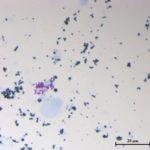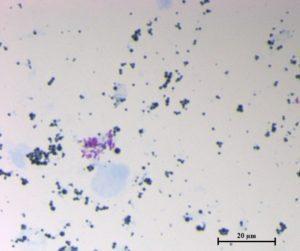Paratuberculosis or Johne’s disease (JD) is a debilitating chronic granulomatous enteritis affecting ruminants worldwide caused by Mycobacterium avium subsp. paratuberculosis (MAP). JD is a serious economic concern to the dairy and beef industries due to reduced productivity and early culling of infected animals. In addition, the zoonotic role of MAP in Crohn’s disease is still currently being discussed.
The role of gamma delta (γδ) T cells in the pathogenesis of mycobacterial infections is receiving a growing interest due to their diverse functions spanning the innate to adaptive immunity. Particularly, bovine γδ T cells are differentiated into two phenotypically distinct subsets based on the surface expression of the workshop cluster 1 (WC1) molecule. The WC1− subset represents the majority of γδ T cells in organs such as the spleen and intestine, while the WC1+ subset is primarily found in peripheral blood. This WC1+ γδ T cell subset is divided into three different serological subpopulations: WC1.1, WC1.2 and WC1.3. It is known that the response to stimulation with antigens vary between these subpopulations.
The goal of the study was to evaluate the immunological functions of WC1+ γδ T cell subsets in cattle naturally infected with MAP to better understand the role of these cells in host defense during natural MAP infection. They had evaluated WC1+ γδ T cells in subclinical and clinically infected cattle to address two questions concerning the relationship of WC1+ γδ T cell subsets to shifts in immune responses and progression to the clinical disease.
First they determined the frequency of γδ T cells from PBMCs from non-infected cattle as well as from clinical and subclinical infected animals via flow cytometry. They found that the percentage of total γδ T cells in peripheral lymphocytes was lower in infected animals and this was significant in the clinical group. They also found that in the subclinical and clinical groups, the percentages of circulating WC1.2+ γδ T cells were significantly lower compared to that of the control group.
Secondly, they evaluated the frequency of γδ T cells by immunofluorescence in distal ileum as it is the primary target tissue of MAP. The results show that in non-infected and clinically infected cattle, γδ T cells in the distal-ileum were predominantly WC1− and were frequently observed near or within the mucosal epithelium. They concluded that the data obtained indicates no significant differences among the examined groups with regard to the frequency of γδ T cell subsets in the ileum.
Finally, they studied the capacity of PBMCs to respond to in vitro stimulation with MAP antigens (Ag). They labeled these cells with CFSE and cultured them in the presence or absence of PPD-J. Cultures were analyzed by flow cytometry for cells co-expressing γδ TCR and either WC1.1 or WC1.2 that had proliferated in response to Ag, as measured by CFSE dilution. Total peripheral γδ T cells from cattle naturally infected with MAP proliferated specifically in response to PPD-J and this response was restricted only to the subclinical group. At the end of the essay their results indicates that WC1-expressing cells in peripheral blood of cattle with subclinical JD proliferate in response to one or more PPD-J antigens.They also evaluated the IFN-γ and IL-10 production by WC1+ γδ T cells in response to stimulation with this antigen. They found that intracellular IFN-γ production by total γδ T cells was comparable between the subclinical and clinically infected animals. Interestingly, the percentages of PPD-J specific IFN-γ+ WC1.1+ γδ T cells were significantly higher in subclinical cattle compared to noninfected and clinically infected cattle. On the other hand no significant difference was found between the three groups in the percentages of IL-10+ γδ T cells.
In conclusion, WC1+ γδ T cells respond differentially to stimulation with one or more of MAP antigens. They also report that the frequencies of circulating γδ T cells were significantly reduced in cattle with the clinical form of MAP infection. In addition, they observed no significant differences in the percentages of circulating γδ T cells between noninfected cattle and cattle subclinically infected with MAP. In the subclinical group, γδ T cells proliferated specifically in response to ex-vivo stimulation with PPD-J, a response that was a heterogeneous mix of WC1.1 and WC1.2 subsets. These proliferative responses were not detected in cattle clinically infected with MAP.
Although it is an experiment that evaluates the function of these lymphocytes in vitro, it yields interesting results to understand the immunopathogenesis and the progression of the disease to its clinical stage in cattle.
Journal Article: S.M. Albarraka et al., 2017. WC1+ γδ T cells from cattle naturally infected with Mycobacterium avium subsp. paratuberculosis respond differentially to stimulation with PPD-J. Veterinary Immunology and Immunopathology.
Article by Giselle Ingratta

